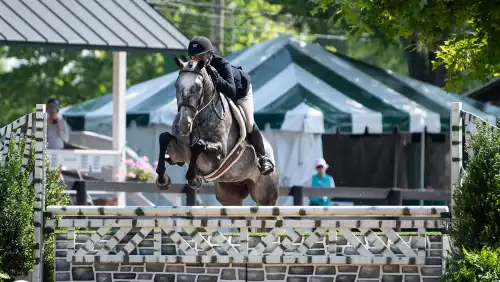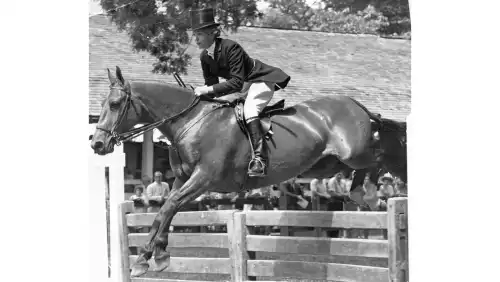Amateur hunter/jumper rider Shelley Sanderson played and then replayed the video of a coppery chestnut Hanoverian with four white stockings and a broad blaze. She played it again. After searching everywhere for her next horse, she knew the hunt was finally over. She purchased the 4-year-old gelding in 2011 and named him Unwritten, inspired by Natasha Bedingfield’s popular song.
“We wrote quite a story,” said Sanderson with a laugh. “Sometimes life doesn’t quite go the way we want it to, and I always say about horses: It isn’t on our time; it is on theirs.”
Now 13, “Ziggy” (St. Moritz—Paola) has recovered from major lameness and colic surgery, followed by complications requiring a second surgery and an unusual life-saving medical procedure. Despite these setbacks, Ziggy has returned to the show ring. Through it all, Sanderson stood by her horse and her personal philosophy of horsemanship.
“I have had horses since I was 7, and when something goes wrong, we need to find out what it is, treat it the best we can, and know that the body heals,” said Sanderson. “Horses are these giant animals that are very sensitive. Things happen, and we just have to take care of it.”
When Ziggy arrived from Germany, Sanderson sent him directly to her trainer Patrick Spanton for further education, and Ziggy made an impression immediately.
“I have it on video, and you can hear him go, ‘Wow, he is the smoothest horse you’ll ever ride,’ ” said Sanderson.
Spanton helped Ziggy gain confidence in the show ring during his 5-year-old season, and Sanderson started taking the reins, but at the end of the year, Ziggy went lame. The symptoms persisted after conservative treatment. An MRI revealed an injury to the lateral collateral ligament in his left foreleg. Sanderson proceeded with shockwave therapy, Tildren injections and rest.
“I did everything I could for him, and I had hope because he’s a tough guy,” said Sanderson.
For nearly a year, Ziggy sat on the sidelines. Sanderson did most of the tack-walking phase of his rehabilitation, but when he turned 6, he developed a playful attitude under saddle, and he grew even taller. Since she’d recently moved to Camarillo, California, Sanderson found a colt starter and a new trainer, Chelsea James, to get Ziggy back on track.
ADVERTISEMENT
“We had started to do a few crossrails, and he was doing well, and that was when he had the colic,” said Sanderson.

Unwritten wore a belly band for several months to help reduce a hernia he developed following colic surgery. Photo Courtesy Of Shelley Sanderson
Veterinarians diagnosed a left dorsal displacement, which happens when a portion of the colon moves up and over the renosplenic ligament, often getting trapped in place by the spleen and kidney. Ziggy was rushed into surgery, and veterinarians were optimistic he would make a complete recovery.
While healing from his surgery, Ziggy developed a massive hernia, and veterinarians tried to reduce its size with the aid of a belly band. But over the next few months, he experienced increasingly frequent bouts of minor colic. Veterinarians theorized that he had developed adhesions, a relatively common complication post-abdominal surgery. Almost six months after his original procedure, Ziggy was referred to the specialists at Alamo Pintado Equine Medical Center in Los Olivos, California. There, he was scheduled for an exploratory surgery with Carter Judy, DVM, DACVS.
“The night before the surgery I was visiting with him, and he’s looking for food, and he looked happy and healthy,” said Sanderson. “I’ll never forget that because when he walked into surgery the next morning, he didn’t want to go.”
Once Ziggy was on the operating table, Judy discovered the likely cause of his continued colics—a tear in the mesentery, which is the sheet of connective tissue that holds the horse’s intestines to the body wall. Ziggy’s intestines were sliding in and out of the opening. Due to the width and location of the tear, and Ziggy’s size—he’s 17.2—Judy recommended considering euthanasia. The only way to repair the tear was to install a permanent wire mesh implant. Judy gave the procedure a 50% success rate. Sanderson had to decide quickly.
“I just looked at him and said, ‘You know, put him back together,’ ” recalled Sanderson. “Here is why I made that decision: He didn’t look like he wanted to die. Every horse I’ve ever owned, they gave me that look, like, ‘I am done,’ or, ‘I’m defeated.’ But not [Ziggy]. I’m a trier, and Ziggy’s a fighter. I wanted to give him a chance.”
Judy inserted the wire mesh implant, and once Ziggy was cleared to leave the hospital, Sanderson trailered him to a lay-up facility 15 minutes from her home where he spent five months on stall rest. She visited him three or four times daily to change bandages, apply ice and administer laser treatments.
“I told my husband I wasn’t going to see him for a while,” Sanderson said with a laugh.
Ziggy continued to wear the belly band and worked up to eating five small soaked meals daily, along with forage in a Porta-Grazer slow feeder. After a few months, Ziggy began taking short hand walks, and eventually he graduated to small paddock turnout. But again, Ziggy experienced episodes of mild colic. Sanderson consulted with an equine nutritionist.
ADVERTISEMENT
“We figured out that he would get gassy,” said Sanderson. “The nutritionist got him on a good diet and added lactic acid yeast, which comes in a tablet, that helps to reduce the gas in his intestines. He is on it to this day.”
Ziggy’s dietary adjustments resolved the recurrent colics, and 10 months after the installation of the wire mesh implant, Ziggy finally left the lay-up facility.
“When I first did the surgery, I figured if he wanted to be a pasture puff that would be fine with me,” said Sanderson. “I tried not to have any expectations. I just wanted him to be comfortable and happy and go from there.”
But Ziggy appeared ready to resume work under saddle, and they gradually increased his workload. In 2018, nearly five years after his last competition, Ziggy returned to the hunter ring at the Blenheim June Classic III (California), with James in the irons, competing in the USHJA 2’6″ schooling hunters.
When James relocated to Chicago, Peter Lombardo took over the ride. In 2019, Lombardo moved Ziggy up into the green hunter divisions. Sanderson planned to take over show ring duties with Ziggy in 2020, but the coronavirus pandemic caused her to re-route yet again. Instead, Sanderson moved Ziggy and her other horse, Matcho, home to her 20-acre property in Ventura County, California, and she’s been keeping them legged up with light arena work and trail riding.
“I used to joke, every time I used to pull up to the barn and see his big red face and see him smiling back at me, it was a good day,” said Sanderson. “Now, I get to look out and see him anytime I want to. I really feel we have a deep connection.”
Sanderson believes in keeping her horses for life, and Ziggy is no exception.
“This horse owes me nothing and has shown me strength I have never seen,” said Sanderson. “I have promised him I would always be there for him, will watch over him, and he has a place with me forever. Horses are the most amazing animals that love unconditionally and have a way of becoming a part of your heart.”
Do you know a horse or rider who returned to the competition ring after what should have been a life-threatening or career-ending injury or illness? Email Kimberly at kloushin@coth.com with their story.

















